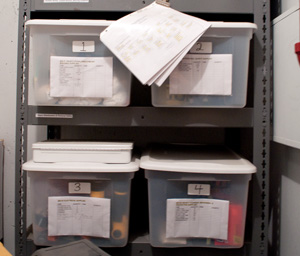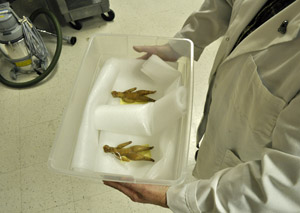Being prepared for an emergency requires forethought, communication, and resources. The Denver Art Museum and other institutions that serve as caretakers for collections have a responsibility to develop an emergency response plan. Here are some of the steps that we have taken with our Emergency Response Plan and how you can take similar precautions with your collection at home—be it art, letters, photographs, or other items you care about.
An institution’s emergency response plan starts with an understanding of the types of events that could occur and their possible effects. Emergencies could include floods, fires, earthquakes, power failures, mold outbreaks, and many more potential dangers. The plan includes an outline of what staff should participate during an emergency and what roles they should play. Instructions on how to establish and maintain channels of communication under various conditions are important. Facilities access and phone communication may be limited, so alternate arrangements should be understood ahead of time.
Likewise, you can think ahead about what kinds of emergencies are most likely in your home and what areas of your home are most vulnerable. In Colorado, the most common emergency events in homes are storms, floods, and fires, which could lead to damage to objects by collapse of structures, water, soot, or mold. As suggested in the DAM’s earlier blog post about caring for objects at home, one step you can take is to avoid storing objects directly on the floor in basements or elsewhere.
First responders (police, firefighters, EMTs) who are addressing safety concerns during an emergency operate under an incident command system (ICS). Understanding and working with that system will allow museum responders to take appropriate steps while staying safe and not impeding these important efforts.
Personal health and safety are most important. Do not risk injury or illness to salvage objects in your home. Communicate with but do not interfere with activities of first responders.
At the DAM, procedures for emergency response include taking health and safety precautions by use of personal protective equipment. This equipment is regularly maintained and inventoried to ensure that it is available when needed, and staff are trained in its location and proper use.
You can put together an emergency response kit at home with items like latex gloves, towels, plastic sheeting to protect objects from water leaks, tape, a fan, an extension cord, flashlights, batteries, etc. Include contact information for your insurance agent and local conservators and tips on recovery techniques on laminated paper. Keep the kit in a location that is most likely to be accessible in an emergency scenario.
An object may need to be moved to avoid potential damage in an emergency situation, for example, away from a vulnerable window or up to a higher floor in the building. Having a current inventory of the collection and a priority list for evacuation will help to make difficult decisions under pressure.
Similarly, you can make an inventory of important objects in your home and note which would be highest priority to recover in case of an emergency. Insure valuable objects and document their appearance and condition with date-stamped photographs. Keep a copy of this documentation, your policy number, and your insurance agent’s contact information in a location other than your home. Be sure to review your policy carefully to understand what it does and does not cover.
Salvage techniques for collections are determined by the materials present as well as the type and extent of damage. Paintings, wooden sculpture and furniture, ivory, and other multi-layer materials are very susceptible to water damage. Porous materials such as paper and textiles can hold large amounts of water, making them significantly heavier than in their dry state. They are also usually weaker when wet, and require special support when handling. Soot can easily be rubbed into surfaces when handling, and over time may bond chemically with an object’s surface. If an object has broken, the best chance for repair is to retain all pieces within appropriate wrapping materials. Careful handling and wrapping of objects that have been affected by an emergency can limit irreversible damage.
The resources below give additional tips on safely recovering objects damaged in disasters. Consult these resources and try to anticipate what your collection’s needs may be in an emergency.
Taking steps to prepare for an emergency will help to minimize damage and loss, no matter the size of the collection.
Additional Resources:
- AIC Caring for Your Treasures
- Heritage Preservation
- Library of Congress
- MoMA/AIC CERT Consortium on Recovery of Works of Art Damaged by Flooding
- American Institute for Conservation - Collections Emergency Response Team (AIC- CERT)
- National Parks Service, Museum Handbook, “Emergency Planning”
Image credit: Brian Papantonio, Lightning Strikes Downtown Denver, 2011.
Kate Moomaw, assistant conservator for modern and contemporary art in the conservation department, also contributed to this blog post.


